2020 Year-in-Review
Profiles in
Perseverance


CSBA salutes YOU
Governance teams across California jumped into high gear this spring when every school in the state closed for physical instruction due to the COVID-19 pandemic. Education leaders navigated the shift to a virtual learning environment, while also keeping the physical and social-emotional needs of students and families in mind. The unprecedented challenges of the past year clarified the central role public education plays in our society and underscored the importance of Full and Fair FundingSM for California schools.
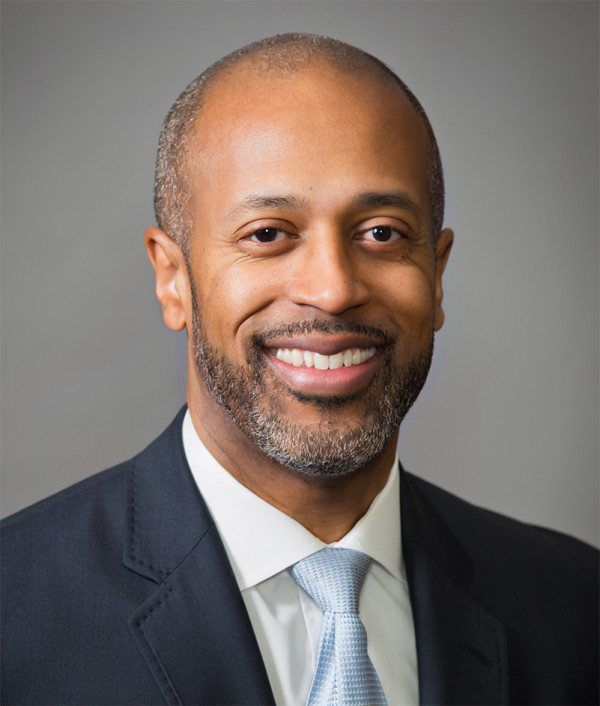
Each winter, we use this Year in Review to reflect on the great challenges and significant victories of the preceding 12 months. 2020, however, was not like any other year and demands a departure from the norm. The COVID-19 pandemic has displaced students, exhausted resources and tested governance teams like never before. Yet, faced with a once-in-a-lifetime challenge, school district and county office of education boards have responded in remarkable fashion. Your resourcefulness and innovation have been invaluable for California students during a most critical time. That kind of commitment deserves special recognition.
In this year’s annual review, we are turning the proverbial camera on you. Instead of focusing on CSBA’s advocacy for school districts and county boards of education, we are highlighting what local educational agencies have done to serve students under incredibly adverse conditions. Recent months have reinforced that schools are more than educational institutions, they are hubs of community and essential to the proper functioning of our economy.
Governing boards have always gone beyond the call of duty to help schools fulfill their special mission, but 2020 stands as the year when you have truly distinguished yourself. Trustees have adjusted on the fly to provide the policy, advocacy and support required to face an invisible adversary in uncertain times. You have guided the transformation of school districts into food distribution services, health care providers, technology service firms and child care centers. You have done all this while subjected to unprecedented scrutiny and critique. There is no reward other than the knowledge that your efforts are supporting students at this most critical moment.
 I think a hero is an ordinary individual
I think a hero is an ordinary individual
who finds strength to persevere and endure
in spite of overwhelming obstacles.”
Christopher Reeve
Of course, you didn’t run for school or county office board for the glamour or because it was easy — and it certainly wasn’t in 2020. You ran for school board because you believe in public education and wanted to make a difference for California students — and you have. This may not be how you imagined it, but however difficult this year has been, you have played a crucial role in sustaining public education and preparing for the next chapter of our ongoing mission to provide a high-quality education for every California public school student.
Local educational agency boards are the unsung heroes of the pandemic and CSBA is determined to make sure your efforts are appreciated. We spent much of 2020 making the case for greater funding and clearer guidance for LEAs so you could have the flexibility and resources required to meet your local needs. We will expand those efforts in 2021, but, in the meantime, we want to celebrate your accomplishments and those of your colleagues across California. Thank you for the essential work you did in 2020 and for the impact it has made on the lives of 6 million students.
In Appreciation,

Bridging the digital divide
While California has made great strides in recent years to close the digital divide in its schools — with a vast majority meeting federal technological targets for digital learning — distance learning efforts forced by the COVID-19 pandemic shined a large spotlight on the “homework gap.” As education leaders across the state planned for and ramped up the delivery of distance learning lessons, many faced a fundamental and daunting barrier: the number of students who lack access to computers or other mobile devices and internet at home.
LEAs immediately began laptop distribution plans after determining need through surveys. Many designated specific times for different groups to pick up devices and hotspots, others distributed devices at school meal pick-up sites. Those that had already implemented a 1:1 device ratio were most ready to tackle the other challenges of distance learning. ABC Unified School District in Cerritos just this year completed a five-year initiative called the Technology Integration Program, which provided devices for all of the 20,000-plus students in the district, along with training for teachers and students, and infrastructure and technical support. Part of TIP is integrating on-site and online curriculum in the district and the IT team is included in textbook adoption decisions to ensure the curriculum can be supported and facilitated through the Google Classroom platform. Superintendent Mary Sieu emphasized how this five-year initiative helped the transition to distance learning go much more smoothly. “The Online Learning at Home program can be customized to what students need right now,” Sieu said. “The students and families still have access to the very programs that they have had while they have been in school.”


Before this, we as a small school district in rural Tulare County were trying to do whatever we can to bring opportunities for STEAM into our classrooms. And those types of opportunities require access to internet. I really see it as a fundamental necessity that everyone needs and should have.”
Abigail Solis, Board President
Earlimart ESD

 The district’s plan to partner with Motorola Solutions to provide reliable internet access to students in their homes started well before the COVID-19 pandemic. This is the most significant equity issue facing students in the 21st century. We simply couldn’t wait any longer or rely on others to solve the problem for us.”
The district’s plan to partner with Motorola Solutions to provide reliable internet access to students in their homes started well before the COVID-19 pandemic. This is the most significant equity issue facing students in the 21st century. We simply couldn’t wait any longer or rely on others to solve the problem for us.”
Phil Alfano, Superintendent
Patterson Joint USD
Monterey Peninsula USD is using some of its school buses parked around town as makeshift WiFi hotspots for its students and staff to stay connected for distance learning. The district deploys the buses to convenient locations near areas in which surveys to students and staff indicated there is the greatest need. The idea is for students and families to park around the bus to access their schoolwork when they cannot do so at home. Each bus will be able to handle about 150 devices connecting to the WiFi and has about a 150-foot radius.
In rural areas, it can be much harder to not only reach students but to provide them with the resources they need to meaningfully engage in distance learning. However, these obstacles are not stopping the state’s less-populated districts from making sure their students are still learning. Earlimart Elementary School District, located north of Bakersfield in Tulare County, has about 1,600 students with nearly 94 percent qualifying for free and reduced-price lunch. The district has been working to close the digital divide for years and had already achieved a 1:1 ratio for devices. However, not all families had an internet connection, either because a signal did not reach their home or due to affordability. The district purchased two antennas that were installed at schools on either end of town to extend the cell signal to up to 800 families. Hotspots were purchased with differing ranges, one within 1 mile and the other within 7 miles. District-issued devices connect to a filtered internet signal automatically. The project was paid for with Coronavirus Aid, Relief and Economic Security (CARES) Act funds.
While pleased that the district has implemented a workable solution, Earlimart ESD Board President Abigail Solis expressed concern about the slow pace of progress at the state and national levels. “Before this, we as a small school district in rural Tulare County were trying to do whatever we can to bring opportunities for STEAM into our classrooms. And those types of opportunities require access to internet,” she said. “I really see it as a fundamental necessity that everyone needs and should have.”
Further north, Patterson Joint USD in Stanislaus County was looking to provide an innovative solution to connect families in need in the district of about 6,000 students. A technology initiative over the last five years provided every student with a device, and hotspots were provided to those in need when schools closed last March. While these measures provided a temporary fix to connectivity barriers that many Patterson families faced at the time of the closure, data limitations and the lack of proper firewall security led the district to partner with Motorola Solutions to provide private broadband towers to provide free, reliable and secure internet access to all Patterson students.
“The district’s plan to partner with Motorola Solutions to provide reliable internet access to students in their homes started well before the COVID-19 pandemic,” Superintendent Phil Alfano said in a statement. “This is the most significant equity issue facing students in the 21st century. We simply couldn’t wait any longer or rely on others to solve the problem for us.”
Even in the tech-center of the country, internet access is not a given. In San Jose’s East Side Union High School District, an innovative project to provide widespread internet access is underway, but only partially completed. The Community Wireless Project, a partnership between the city of San Jose and East Side Union HSD, has been a centerpiece of the mayor’s plan to help with digital inclusion in San Jose. The project is building one of the nation’s first school district-funded municipal WiFi infrastructures, bringing free broadband access to thousands of district families and tens of thousands of residents in East Side.
In a national survey this summer, more than three in four school social workers reported that a majority of students at their schools needed serious mental health supports in the wake of the COVID-19 pandemic, school closures, economic hardship and a convergence of other factors. LEAs have gotten creative with counselor check ins, digital support groups and telehealth offerings along with creating and continuing music, theater and art programs, which research shows provide students further connections and investment in their schools.
In L.A. County’s Baldwin Park Unified School District, preparation started prior to extended school closures on how to continue serving students who were receiving services. The community-based mental health agencies the district works with immediately began shifting to offer virtual counseling. The school mental health personnel talked with teachers and other school leaders to identify the students who were in greatest need and how to stay in contact with them, whether it be by phone, by email, by Google Classroom, Google Hangout or by postcard — any way to not lose connection with them.
Social-emotional learning is also a priority in Santa Rosa City Schools, where the Board of Trustees’ mission statement includes SEL as a priority. Teachers can utilize common learning time on Wednesdays for professional development. The district is also offering families/guardians social and emotional learning training to help them with their roles in distance learning. The district’s Integrated Wellness Center is still providing emotional and mental health support for students, staff and families that can be requested through an easy-to-use online form.
Districts are also building off already-established relationships to continue to serve students that may be experiencing difficulties in their social-emotional and mental health. Long Beach USD is using school nurses to reach out to families with a known history of health and attendance challenges, as well as using family resource centers and a number of other sites to provide meals and resources. The focus on well-being also extends to district staff, particularly those on the frontline helping students through difficult times. Stockton USD is contacting students who were receiving school-based mental health services prior to school closures to arrange telehealth services. The district also established a helpline that students and families can use to speak directly to mental health clinicians, child welfare and attendance staff and other health personnel during school closures. Mental health and behavior staff are also available to answer questions and provide guidance for accessing community resources.
In Bakersfield City School District, a proud tradition of an award-winning music and arts education is helping educators hit the right notes. While educators can’t replicate an in-person setting of collaboration and stirring ensembles, they are advancing existing relationships or forging new ones — and offering a change of pace from the monotony of other digital coursework. When a teacher is effective and makes the music or arts class fun and interactive, the students want to be there,” said a district representative. “What I see from observing in Zoom classes is that the music teachers are considered in high esteem by their students because they have done experiences with their teachers of going on trips and performing together.
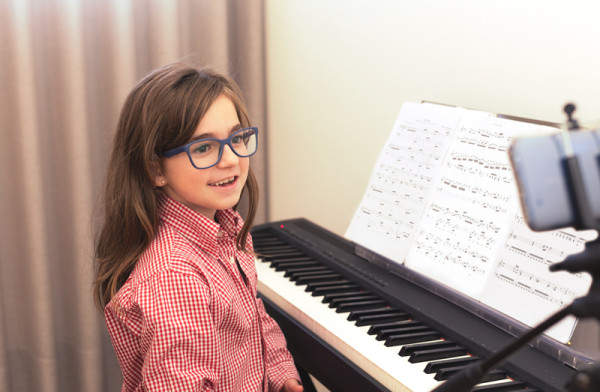
 What I see from observing in Zoom classes is that the music teachers are considered in high esteem by their students because they have done experiences with their teachers of going on trips and performing together. And because of that experience, they look forward to going to music because they know they’re going to get to continue that teacher–student relationship that they’ve already begun.”
What I see from observing in Zoom classes is that the music teachers are considered in high esteem by their students because they have done experiences with their teachers of going on trips and performing together. And because of that experience, they look forward to going to music because they know they’re going to get to continue that teacher–student relationship that they’ve already begun.”
District representative
Bakersfield City School District
And because of that experience, they look forward to going to music because they know they’re going to get to continue that teacher–student relationship that they’ve already begun.” The arts and other non-core subjects are often the first to go in a budget crunch or may be an afterthought in the realm of distance learning, but Bakersfield City SD maintained its music department’s staffing at current levels this year, and so far student participation looks healthy.
The Riverside County Office of Education saw an opportunity to bring their virtual student body together through art and launched the Art Connects virtual student competition just eight days after school closures. Weekly winners from multiple age groups and their inspiring work were highlighted on the RCOE website and social media, and information was distributed to local media. Students’ work was also shared with educators to keep them connected with the organizational mission of serving students. More than 1,300 student creations of poetry, visual arts, dance, theater, videos and music shared artistic expressions of change, possibility, kindness, persistence, connections and hope. The project garnered interest as other county offices of education, school districts and arts organizations across the state began contacting the Art Connects team for tips on creating similar programs for their students. According to feedback from one parent: “Thank you for this program, it has been the only thing that gets my daughter out of bed every morning and it is pretty much all she talks about.”
Student achievement
LEAs are working in real time to address the needs of every student — including those that need extra support, such as English learners and students with individualized education programs (IEPs) — whether instruction is through distance learning or in the classroom. Distance learning programs are constantly being adjusted and finetuned as educators see what is and isn’t working for their students. Emergency learning plans thrown together when schools closed in the spring have given way to more thoughtfully planned systems that do their best to serve every student within its limitations. Many districts used the summer months to provide further professional development in online instruction for teachers.
Large districts were able to tackle distance learning with hefty contracts and investments, which can require detailed planning and input from teachers. Los Angeles USD made a $77 million investment last year with connectivity to address the digital divide. While not every student is connected, the district has made large inroads. Standardizing software and programs were necessary to track student attendance and usage in a formal way when the 2020–21 school year began and the district chose the Schoology learning management platform for this purpose. To still allow teachers choices in what programs they used in their virtual classrooms, the district surveyed teachers to determine the top 20 most-used applications — of almost 400 — and created data-use agreements with each one to obtain the reports they need.
The district also spent the summer doing a detailed analysis of its own program offerings and filling in gaps it found in online curriculum in areas such as high school science and music. District leaders also knew they needed to build in extra supports for English learners. In addition to providing EL Instructional Coaches to support teacher capacity and professional development at schools with high EL populations, and newcomer coaches/counselors at high schools with high newcomer populations, the district contracted with Rosetta Stone for additional asynchronous learning supports. Hybrid opening plans, when the time arrives, include additional ELD instructional support twice a week to support extended learning opportunities for English Learners. LAUSD has also increased its tutoring efforts.
Students in need of special education services are one of the hardest hit groups in the pandemic, as the majority of services are meant to be provided in person. Many districts are now bringing students with disabilities onto campuses in small cohorts, as allowed in state guidance. Others are working within the constraints of distance learning to provide services as best they can.
Though now open to students with a hybrid schedule, while schools were closed Plumas Lake ESD provided general education instruction in Zoom video conferences, with paraprofessionals providing additional supports in small group Zoom breakout rooms or in separate follow-up Zoom sessions. The district’s speech and occupational therapists also shifted to online sessions.

Students in need of special education services are one of the hardest hit groups in the pandemic, as the majority of services are meant to be provided in person. Many districts are now bringing students with disabilities onto campuses in small cohorts, as allowed in state guidance.
The Humboldt-Del Norte Special Education Local Plan Area created distance learning plans by looking at already-agreed-upon goals and objectives from students’ IEPs to inform what services teachers can realistically implement. Representatives from the SELPA said the limitations of distance learning should not stand in the way of making meaningful virtual connections. Differentiations are made based on student abilities and capabilities as well as by method of instruction — whether it’s printed and mailed packets, phone calls, emails or online platforms.
Five county offices of education worked together in the California Collaborative for Educational Excellence’s Distance Learning Consortium. Kern, Orange, San Bernardino and San Diego COEs have been collaborating to build and share downloadable distance learning content on learning management systems, with Shasta COE providing technical support for rural LEAs.
Early data and research show that students will lose more ground in math than in reading during distance learning. Santa Ana USD has experienced this drop and is using data from assessments to identify struggling students and provide early intervention. Scheduled office hours allow teachers time to customize assistance and work in small groups.
Nutrition
About half of California’s more than 6 million students are eligible for free and reduced-price school meals. With the state’s unemployment rate rising at record levels, those meals are needed more than ever. Districts and their respective schools have stepped up to make sure no student goes hungry during school closures.
The largest operation in the state belongs to LAUSD, where, just in the first week and half of opening its 60 grab-and-go food centers, more than 2.3 million meals were distributed, according to district officials. As of Nov. 30, 82.5 million meals had been served. The effort has involved partnerships with local foodbanks as well as celebrity chef José Andres. Meal-distribution sites are staffed by hundreds of volunteers coordinated through the American Red Cross.
In the small Northern California district of Trinity Alps Unified, one school is providing a grab-and-go service. However, the district’s large geographical area makes it difficult for a majority of the almost 750 students to come to the distribution site. For those students, the district is sending meals with their bus drivers, who deliver them to more than 50 locations in the district’s service area.
Back in an urban setting, Oakland USD had served more than 4 million meals since the end of March. The district is also partnering with local food banks and other community partners to provide additional essentials to Oakland families during their time of need. For example, the Alameda County Community Food Bank has provided more than 20,000 bags of fresh produce, Oakland Promise – Brilliant Baby has provided more than 200,000 diapers and the Berkeley Humane Society has provided more than 4,500 pounds of pet food.
Many schools also stepped up to help families in need this holiday season. The Livermore Valley Joint USD distributed 300 holiday meal kits to families for Thanksgiving break. Since the beginning of the pandemic, LVJUSD has distributed more than 320,000 free meals — including breakfast, lunch, dinner and a snack — at eight pick-up locations.
With the state’s unemployment rate rising at record levels, those meals are needed more than ever. Districts and their respective schools have stepped up to make sure no student goes hungry during school closures.
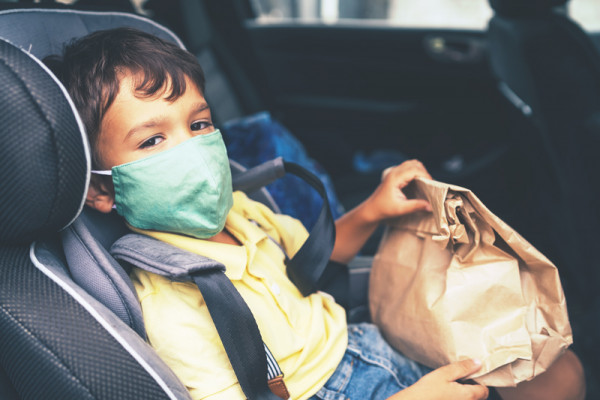
Health, safety and
reopening schools
The pressure and scrutiny on decision-makers is immense as public education has been thrust into the spotlight as a fulcrum in determining the shape and pace of the state’s recovery from a crippling disease. The high-pressure environment impacts leaders not only of schools that have already opened with some form of in-person instruction, but for officials who will have to determine how and when campuses should reopen once their counties exit the watch list.
Elementary school waivers
The reopening process for the state’s schools began for some in early August when the California Department of Public Health outlined a waiver process through which local educational agencies in counties on the now-defunct COVID-19 monitoring list can seek to resume in-person instruction at elementary schools. Dr. Erica Pan, California State Epidemiologist, said that when considering exceptions, officials looked at not only who would “benefit most from in-person instruction, but also who would be the lowest risk of getting infected in that setting and then infecting others.”
Working tirelessly during the summer, the Lucerne Valley USD maintenance and custodial staff installed clear desk partitions in classrooms, outdoor handwashing stations, hand sanitizer dispensers, upgraded air filters throughout campuses, installed touchless temperature scanners at both school sites, touchless student check in for students in the cafeterias, and countless other jobs. Disposable gloves and face shields were purchased for staff members along with masks for students. A year’s supply of hand sanitizer was purchased and made available throughout each campus. District leaders also planned to open with a hybrid model with fewer students on site, allowing the school to stagger lunchtimes and provide spacing on the playground and field areas. The school day is shorter but features teacher online office hours and instruction for students in both cohorts for the days they are not on campus. On Aug. 12, the district’s waiver request to open the elementary school for in-class learning became the first waiver approved by San Bernardino County’s health officer and on Aug. 20., Lucerne Valley Elementary School opened for its first day of in-person learning.
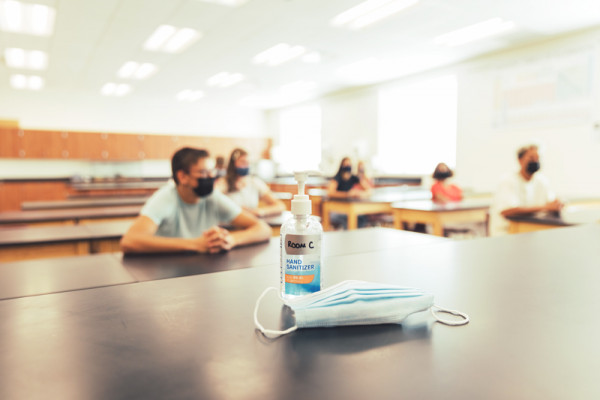
Working tirelessly during the summer, the Lucerne Valley USD maintenance and custodial staff installed clear desk partitions in classrooms, outdoor handwashing stations, hand sanitizer dispensers, upgraded air filters throughout campuses, installed touchless temperature scanners at both school sites, touchless student check in for students in the cafeterias, and countless other jobs.
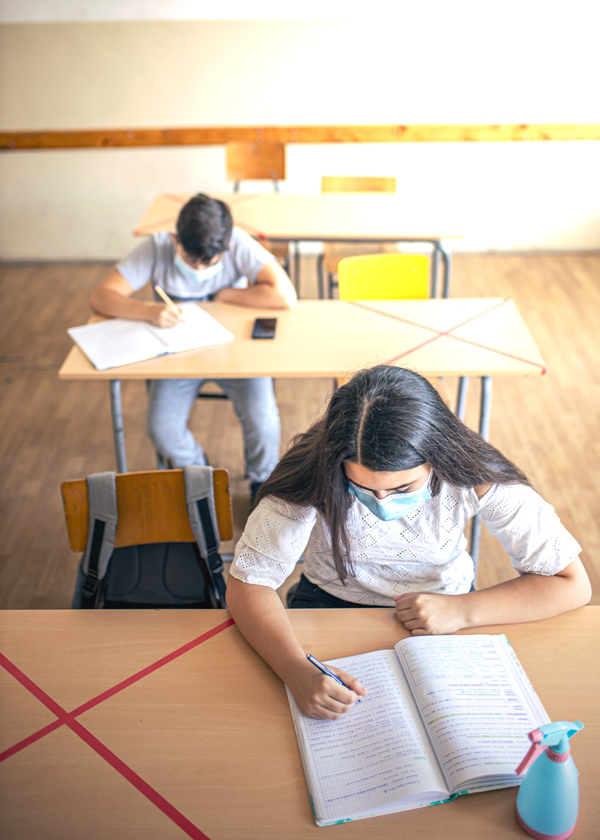
Cohorts
The California Department of Public Health on Aug. 25 released guidance allowing LEAs in counties on the state’s COVID-19 monitoring list to offer in-person, targeted, specialized support and services to small groups of students. The guidance allows stable cohorts that stay together throughout the day of no more than 16 individuals. The determination of which students will be brought onto school grounds in cohorts during school closures is made at the LEA- and school-level based on the needs of students.
The first cohorts in Modesto City Schools began on Sept. 14 and are now meeting at both the elementary and secondary school level. The district has prioritized bringing back to campus students with disabilities, English learners, homeless and foster youth, younger children that have been left home alone, and those without a stable internet connection. Available space at the school sites, as well as availability of support staff and paraprofessionals, will determine the size and number of cohorts in the district. Supervising staff is coming from the district’s pool of classified staff, after-school program staff and through partnering with the city’s parks and recreation department and Boys & Girls Clubs. The district is well prepared for when schools will be able to open on a larger scale, with plans for in-person, hybrid and independent learning.
Reopening campuses
As all districts are making reopening plans, most of the actual reopening has happened in smaller, more rural districts. However, some larger districts have been able to reopen their schools. LEA leaders agree that planning hybrid schedules, addressing health and safety protocols thoroughly, and communicating with the community are key.
One of the forerunners of reopening, rural Fall River Joint USD welcomed students back to campuses with a hybrid model. The Shasta County district of about 1,200 students knew it needed to open as soon as possible due to lack of internet access in its remote location. When schools closed, the district made schoolwork packets available to any student that lacked a connection. The summer was spent planning exhaustive COVID-19 safety protocols, ordering extensive PPE, establishing routines on student cohort movement and negotiating with labor unions. Open communication proved invaluable for Fall River USD and community feedback indicated that most families wanted to return to in-person instruction. “Communication is the key to success,” said Fall River Joint USD trustee Teri Vigil.
The district is conducting assessments to meet children where they are in their learning and providing tutoring support for those in need. Schools have monthly, site-based data meetings where each student’s achievement is looked at and evaluated to see if they need extra support. Support staff will work with at-risk students in small groups and individually.
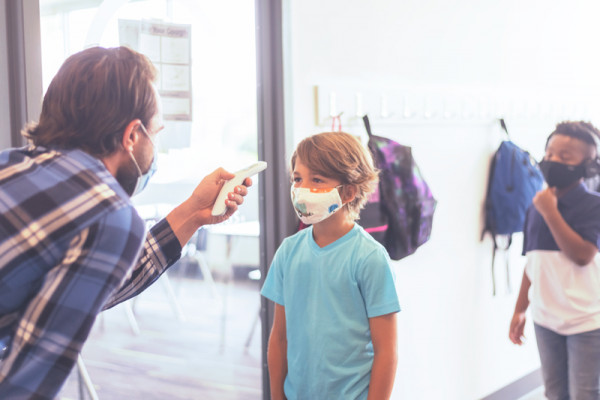
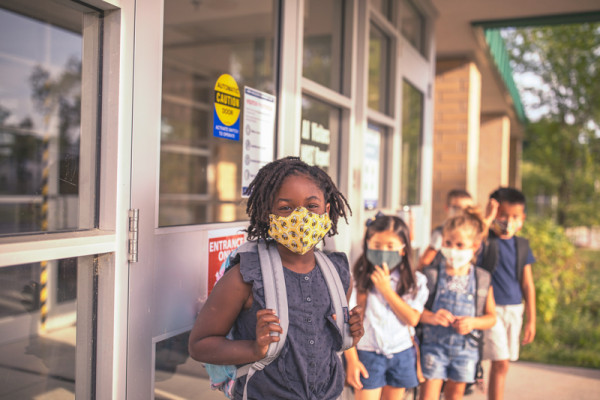
When COVID-19 shutdown schools last March, Cajon Valley USD immediately began planning for what schools would look like when it could reopen. The district began offering free child care for essential workers in April, one of the only districts to do so, said Superintendent David Miyashiro. “In order to do that, we had to set up our site,” he said. “That experience led to offering our free summer learning and enrichment to all of our students during the summer — about a third of our kids came back for that, about 6,500 students.”
The San Diego County school district with more than 17,000 students is now open for all students who would like to participate in in-person learning, which nearly 70 percent have chosen to do as of mid-October. Miyashiro said that open, two-way communication is key to ensuring all stakeholders, from teachers and staff to families, feel comfortable that they will be safe. The summer program allowed the district to put protocols into action and see what works. “In addition to the 6,500 kids, we also had about 1,200 staff, teachers and classified come back to the school site to help facilitate and run the program,” he said. “We used that as a feedback and an input tool to help us improve.”
All students, whether through distance or in-person learning, have worked with their teachers and classroom assistants on comprehensive diagnostic assessments and computer adaptive tools for goal setting and progress monitoring. Personalized and blended learning has been in place since 2014 in the district. In-person learning models are decided depending on school size and the percentage of students who would like to participate. Some schools can accommodate all students five days a week, but many are implementing hybrid schedules to accommodate COVID-19 safety measures.
Napa Valley USD reopened schools with a hybrid schedule in late October and have reported that less than 1 percent of COVID-19 transmissions have been linked to schools. Giving district students and families the choice to return in person or continue with distance learning, about half of students returned to classrooms in October, with all safety precautions in place. The data collected by the district so far shows that those who have opted to return in person are faring better academically than those in distance learning. The board engaged its student member to conduct focus groups with students representing elementary, middle and high schools to gauge what students need to improve their distance learning experience. Based on feedback from these groups, the district identified the asynchronous learning time as when they were losing student attention. As a result, the district is working to transition away from asynchronous learning entirely and implementing simultaneous teaching, where half the cohort is in the classroom and the other is watching the lesson in real time from home. The goal is to have kids in class in one form or another, fully engaged, from 8:10 a.m.–2:50 p.m.
CSBA in service
COVID-19 specific response:
While LEAs throughout the state were navigating the fallout from COVID-19, CSBA was pivoting to support this work. We’ve selected a few highlights for this report to illustrate how we’ve aligned with the needs of school districts and county offices of education during this most unusual and trying time.
Beyond COVID
While much of our focus in 2020 was directed toward the COVID-19 response, we also devoted plenty of energy to the type of support LEAs needed before the pandemic and will require in the future. We are sharing just a few examples of that work here.

































Social-emotional and
mental health supports